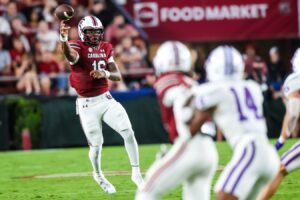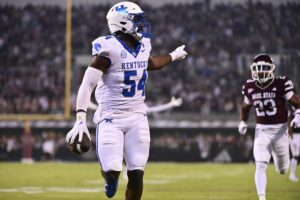Last Word on College Football Book Review: Violated: Exposing Rape At Baylor University Amid College Football’s Sexual Assault Crisis
Title: Violated: Exposing Rape at Baylor University Amid College Football’s Sexual Assault Crisis
Authors: Paula Lavigne and Mark Schlabach
Publishers: Center Street Publishers
355 pages, $27.00
Release Date: Tuesday, August 22nd, 2017
“All In”
When Tevin Elliott, one of the central figures of the Baylor sexual assault scandal, asked Baylor head coach Art Briles to testify on his behalf in his rape trial in January of 2014. Briles responded, via text, “Always all in with my players.”
“Always all in with my players.”
In Violated, Exposing Rape at Baylor University Amid College Football’s Sexual Assault Crisis, authors Paula Lavigne and Mark Schlabach detail the major allegations and events that exposed complete negligence at one of America’s most respected institutions of higher learning. This is the first in-depth narrative of the Baylor scandal. And as the confluence of sports and society continues to grow in importance in our culture, Violated is a must read for any fan that cares about college football.
But more important than that, it’s a must read for any parent that is or will be sending their children to college.
The Sad Truth
Lavigne and Schlabach chronicle four of the high profile cases that are at the center of the Baylor scandal. But they also examine many of the other cases and even examine some of the other cases from around the nation from the past six years. First and foremost, the authors present a painful account of the devastation of sexual assault and rape on the lives of numerous victims. This is a tough read, by any measure.
And it’s a read that paints a distressing picture of the college culture. At Baylor, certainly, but at almost every other major college to different degrees as well.
After reading Violated, there is no doubt that Baylor had a problem. As one former assistant coach is quoted as saying, “It was one hundred percent a systemic failure.” And while the authors focus on the culture of apathy in the football program, there’s enough material throughout the book to illustrate that this certainly wasn’t just a football issue. Nor is it just a Baylor issue.
“It was one hundred percent a systemic failure.”
A Culture of Negligence
At Baylor, the authors detail a culture caught between the pull of tradition and religion and the push of growth, modern society, and a big time college football program. As the world’s largest Baptist University, many of the Baylor community assumed that sexual assault, rape, and other major crimes didn’t exist on their campus.
Growing Too Fast?
The decision, early in the millennium, to grow the university into a top-tier research institution and develop a big-time college football program was the the catalyst for the hubris of fall. Lavigne and Schlabach show that everyone, from the Board of Regents on down, were so tunnel-focused on wins and losses and the U.S. News and World Report Top Colleges rankings that they lost track of the school’s true mission.
The authors deftly overlay the religious aspect of the university and the necessary political considerations with the rapid growth and ambitious vision without leaning too far to either side. An omission of the religious or politic situations would not do the story justice. If you are going to brand yourself as a Christian-based institution, your moral and ethical failures — of which there were many — must be viewed in that same light.
All Out
Even the team chaplain, at a religious school no less, was clearly culpable of negligence. This was the single thread of negligence throughout the entire crisis. Almost every single sexual assault was reported to someone. The authors detail, in depth, the myriad of places a victim might report a sexual assault. Sometimes it was an assistant coach. At times it was campus police. Sometimes Waco police. Sometimes it was a staff or faculty member. But the common theme is that the reports never made it where it needed to go. While Briles and most everyone else was “All In” for their players, they were almost all “All Out” for the victims.
A Complex Issue
As important as this book is, it isn’t perfect. The issue of sexual assault and rape on college campuses is a complex issue. The authors hint — even in their subtitle — at using Baylor is an example of “college football’s sexual assault crisis.” Even the most ardent of Baylor brand loyalist must admit that Baylor had a crisis. But the authors fall short of addressing the depth of the complexity of the sexual assault crisis across our nation’s colleges and universities.
Acceptance of the College Life
Even with examples at Baylor, Lavigne and Schlabach rarely touch on other driving factors of sexual assault. Fraternity life, rampant alcohol and drug abuse, and a campus law enforcement system that is sometimes non-existent are examples of omissions when discussing this crisis at the macro-level. Even with the Baylor example, the authors use opinions on multiple occasions that an increase in tolerance of alcohol and marijuana among the Baylor leadership might have prevented some of the football program’s problems.
Because Baylor had a strict no alcohol and no drug policy, the football program chose not to conduct drug testing. The majority opinion is that Baylor should relax their policy, rather than enforce that policy across the board. The authors clearly made the case that Baylor football faced a crisis; maybe even drove the crisis at Baylor (4% of the student population accounted for 10% of alleged sexual assaults). But nowhere do the authors present any evidence that college football is the driving force behind the sexual assault crisis across the country.
Legal Questions
By far the most difficult of complexities in this crisis is the legal discussion. Again, the authors don’t provide the depth necessary to frame this topic. The difference between state and local criminal charges — those charges that result in arrest, convictions, and jail — and the Federal Title IX statute are never fully addressed. Most people who follow college sports might know that they are different, but probably don’t understand the impact that those differences have on this topic. Or how they shaped the crisis at Baylor.
The authors dutifully show Baylor routinely avoided Title IX investigation due to a lack of evidence, involvement, or communication from the campus and/or local police department. But they never present how the timelines for these two distinctly different legal matters might affect decision makers. Additionally, the authors never fully addressed the issue of campus police departments and their unique place in the law enforcement community.
Again, with specific focus on the Baylor crisis, neither of these issues were paramount to understanding the crisis. But if the authors intend to extrapolate Baylor’s example across the country, they must address these issues.
And there is always the question of due process. As compelling and believable as many of the victim accounts are, its easy to lose sight of due process. That is the nature of a heinous crime like rape. But the authors edge very close to equating accusations to convictions. The confirmed false accusation from a Baylor student only gets a paragraph. As does the retracted Rolling Stones article on the University of Virginia rape scandal. The Duke “Fantastic Lies” vignette is never mentioned. Any conversation that moves us forward must be an honest and frank discussion that includes all the pertinent topics, no matter how hard the conversation.
A Cautionary Tale
As tough of a read as this book is — and the stories of the many victims is absolutely gut-wrenching — it must become an important reference for both college football fans and parents of college age children.
The authors oscillate from investigative journalism to narrative. The investigative journalism is important to set the facts and frame the reference. However, the lack of almost any primary or original sources and limited interviews leaves the work less authoritative than expected. The narrative is both compelling and powerful. But as mentioned earlier, focuses almost exclusively on the Baylor story and doesn’t effectively address the larger issue.
And that might be the only redeeming value in what happened at Baylor.
Not At My School
There’s no denying that something terrible happened at Baylor. This will not be a pleasant read for anyone, especially someone who calls Baylor home. But judge not — this isn’t just about Baylor. And it isn’t just about football. Violated, along with other short-form news from across the country make it clear that our colleges and universities have a problem.
No, this isn’t just a state school problem. And it’s not just a big school problem. It’s not just a football or athletics problem, either. But in our culture, football is often the gateway to an institution. It’s what people see. And when you are the face of the institution you must be better than this. You must be much, much better than Baylor was.
Players, coaches, staffs, administrators, faculty, alumni, and fans should read this and think about their own institutions. Let others handle the legal questions, the law enforcement questions, and the fraternity issues. Football people must address the football issues. While football is important, it shouldn’t — it isn’t — more important than human decency.
For parents, this is one of the few honest examinations of the dangers of modern college life. Not every party is like the parties detailed in this book. And not every campus is like Baylor. But every campus, and every party, has the potential to be dangerous.
It’s a cautionary tale indeed. One that tells us not to go all in on winning and rankings and players that continue to fun afoul of the law. But to go all in on protecting our schools, our friends, and our sport by doing the right things.
Main Photo:
Embed from Getty Images






